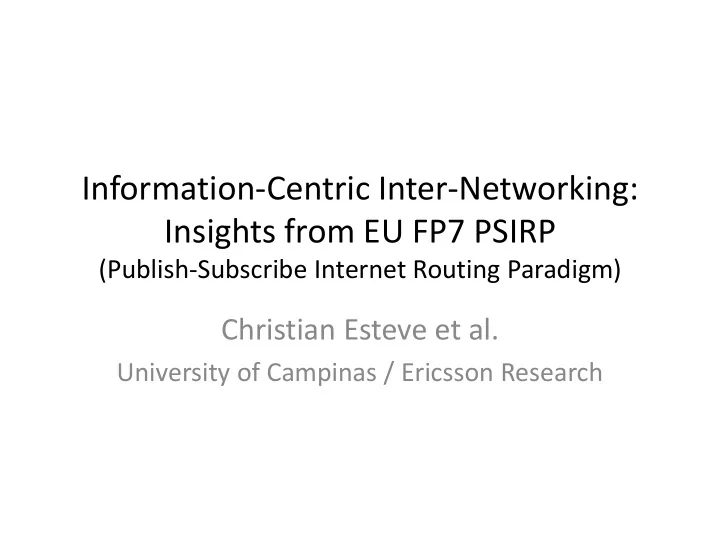

Information-Centric Inter-Networking: Insights from EU FP7 PSIRP (Publish-Subscribe Internet Routing Paradigm) Christian Esteve et al. University of Campinas / Ericsson Research
Motivation • Original Internet: – 70s conversational pipes: host-to-host C/S communications • Now, Internet use (>90%): – Content retrieval & service access – Request & delivery of named data – CDNs and P2P: ad-hoc overlay fixes • Shift to a information-centric point of view : – A new problem to solve (!): • End-to-Data (E2D) • How? – Next Generation Internet approaches solving the “old” E2E reachability problem – Clean-slate design (rethink fundamentals)
Van Jacobson’s vision
Observation Fundamentals of the Internet Reality in the Internet Today • • Collaboration Phishing, spam, viruses – Reflected in forwarding – There is no trust any more! and routing • Current economics favor senders • Cooperation – Receivers are forced to carry – Reflected in trust among vs . the cost of unwanted traffic participants • Information-centric services • Endpoint-centric services – Do endpoints really matter? (mail, FTP, even web) – Endpoint-centric services move – Reflected in E2E principle towards information retrieval through, e.g., CDNs IP with middleboxes & significant IP, full end-to-end reachability decline in trust in the Internet
Paradigm shift *[Esteve et al. 2008]
Approach Clean- slate design… • Question ALL fundamentals • Challenge our thinking • Take nothing for granted, including industry structures • Clear vision …with late binding (to reality) • Consider migration and evolvability in separate work items – How to get our design into real deployments, e.g., overlay vs. IP replacement? • Consider necessary evolution of industry (and regulatory) structures – How do industries need to evolve in certain scenarios?
Project Overview WP1 Management (TKK-HIIT) Project Coordinator Arto Karila Helsinki University of Technology, HIIT WP2 Architecture Design Tel: +358 50 384 1549 Fax: +358 9 694 9768 (TKK-HIIT) Email:arto.karila@hiit.fi WP3 Implementation, Partners : • Helsinki University of Technology Prototyping & Testing (LMF) Helsinki Institute for Information Technology (FI) • RWTH Aachen University (DE) • British Telecommunications Plc (GB) WP4 Validation and Tools • Oy L M Ericsson Ab (FI) (BT) • Nokia Siemens Networks Oy (FI) • Institute for Parallel Processing of the Bulgarian Academy of Science (BG) WP5 Dissemination and • Athens University of Economics and Business (GR) • Ericsson Magyarorszag Kommunikacios Exploitation (NSNF) Rendszerek K.F.T. (HU) Duration: January 2008 – June 2010 Total Cost: € 4.1m Project website: www.psirp.org EC Contribution: € 2.5m Contract Number: INFSO-ICT-216173
Design principles Information is multi-hierarchically organised – Higher-level information semantics are constructed in the form of directed acyclic graphs (DAGs), starting with meaningless forwarding labels towards higher level concepts (e.g., ontologies). Information scoping – Mechanisms are provided that allow for limiting the reachability of information to the parties having access to the particular mechanism that implements the scoping. Scoped information neutrality – Within each scope of information, data is only forwarded based on the given (scoped) identifier. The architecture is receiver-driven – No entity shall be delivered data unless it has agreed to receive those beforehand, through appropriate signalling methods. Publish – subscribe based internetworking architecture restores the balance of network economics incentives between the sender and the receiver
RTFM Architecture* • Rendevouz : Matches subscriptions to publications. • Topology : Creates and maintains delivery trees used for forwarding traffic. • Forwarding : Actual data delivery operations. (label switching and fast forwarding tables) • Mediation : Node-to-node link data transfer & More (opportunistic caching, collaborative and network coding) • RTF functions not necessary co-located in nodes • Recursivity, metadata and identifiers *[Särelä et al. 2008]
Towards Internet-scale • Forwarding state adaptively installed where and when necessary • Balanced trade of overdeliveraries for state reduction and line speed • Secure efficient “source - routing” with fixed sized forwarding identifiers
More information • Project deliverables – http://www.psirp.org/publications • Publications – RTFM: Publish/Subscribe Internetworking Architecture . Mikko Särelä (LMF), Teemu Rinta-aho (LMF), Sasu Tarkoma (TKK-HIIT). Mobile ICT Summit 2008,http://www.ict-mobilesummit.eu/2008/. Submitted on February 8, 2008. – Towards Understanding Pure Publish/Subscribe Cryptographic Protocols . Nikander, Pekka (LMF), Marias, Giannis F. (AUEB-RC). Cambridge Security Protocols Workshop (SPW 2008), – Black Boxed Rendezvous Based Networking . Sasu Tarkoma (TKK-HIIT), Dirk Trossen (BT), Mikko Särelä (LMF). Mobiarch 2008 — The 3rd ACM International Workshop on Mobility in the Evolving Internet Architecture, http://www.sigcomm.org/sigcomm2008/workshops/mobiarch/. Submitted on March 31, 2008. [[1]] – Incentive-Compatible Caching and Peering in Data-Oriented Networks . Jarno Rajahalme, Mikko Särelä, Pekka Nikander, Sasu Tarkoma. Re-Arch'08, www.sigcomm.org/co-next2008/rearch.html. Accepted on Oct 15, 2008. – Towards a new generation of information-oriented Internetworking architectures . Christian Esteve, Fabio Verdi, Mauricio Magalhaes. Re-Arch'08, www.sigcomm.org/co-next2008/rearch.html. Accepted on Oct 15, 2008. • Submitted – PLADO: Packet Level Authentication for Data-oriented Networks . Dmitrij Lagutin, Sasu Tarkoma, Hannu H. Kari. Infocom 2009, http://www.ieee-infocom.org/. Submitted on Aug 29, 2008. – LIPSIN: Line speed Publish/Subscribe Inter-Networking . Petri Jokela, Andras Zahemszky, Christian Esteve, Somaya Arianfar, and Pekka Nikander. (NSDI '09). Submitted Oct 3, 2008.
Conclusions
Recommend
More recommend